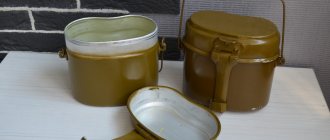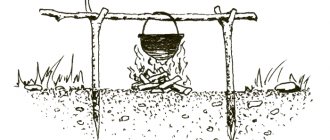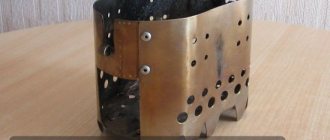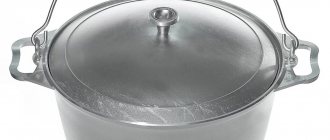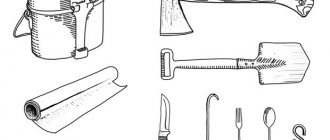In addition to its use in military service, the army bowler hat has gained wide popularity among the civilian population, namely, it is an excellent option for hiking, outdoor recreation, fishing and hunting. Compactness allows you to save space in your equipment, and versatility makes it possible to take a minimum of things for cooking.
In addition to its use in military service, the army bowler hat has gained wide popularity among the civilian population.
Design and use of an army bowler hat
The soldier's bowler hat has an oval shape, where one wall is oblong, for wearing on a belt. The second option is spherical in shape, but such pots are not popular because they are uncomfortable to wear on the body and compact transportation is difficult.
The item is equipped with a handle for carrying the product and hanging it over a fire or burner. The kit includes a lid that can be used as a frying pan for cooking porridge or heating main courses. The handle of the pot is designed to hold the container during cooking, as well as to tightly close the product. A hole in the handle is provided for compact storage of the spoon.
The item is equipped with a handle for carrying the product and hanging it over a fire or burner.
Travel / Equipment / Army (soldier) flask from the times of the USSR - eliminating unpleasant odors.
Army (soldier) flask from the times of the USSR - eliminating unpleasant odors.
Characteristics:
- painted flask (khaki),
- volume 0.75 l.,
- weight 200 gr.,
- made of food grade aluminum
- has an anatomical shape (comfortable when worn on a belt),
- Comes with a standard case; you can also purchase a thermos case.
Advantages:
- you can pour boiling water straight from the fire,
- the ability to boil water over a fire directly in a flask,
- Using a thermos case, the liquid remains hot or cold for a long time,
- since aluminum has high thermal conductivity, the flask allows you to quickly cool boiling water (for example, by placing a flask of boiling water in a stream),
- durable (if you do not take into account dents),
- durable.
Flaws:
- when impacted or handled carelessly, it wrinkles,
- There was an unpleasant odor upon purchase (we will eliminate the odor).
This article will discuss one of the disadvantages of an army flask, namely the unpleasant odor and the fight against it. Over the long period of time I used the flask, I found two effective options for eliminating unpleasant odors. The cause of the fuse is the rubber gasket in the lid of the flask. This is the gasket that needs to be replaced.
Option one.
The material you need is a cork from a champagne bottle, a hacksaw for metal and a sanding block.
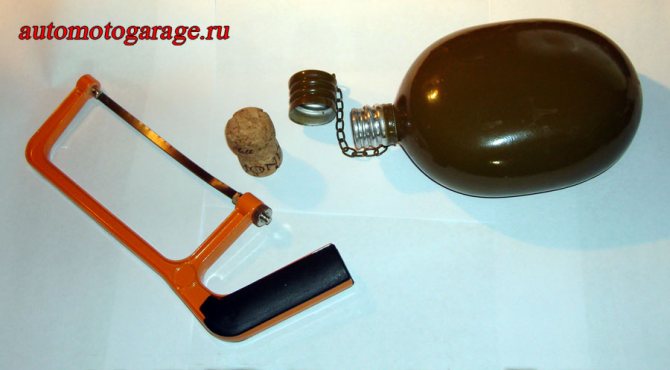
The bottle cap itself should be made of cork material.
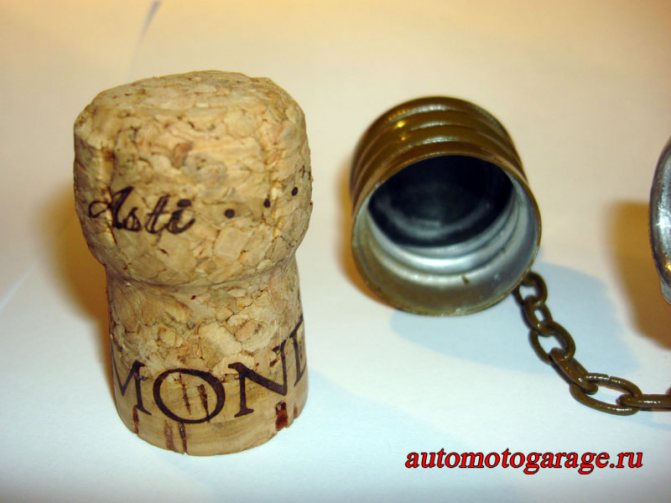
It is necessary to saw off the top part of the plug with a hacksaw, a millimeter thicker than the standard rubber gasket.
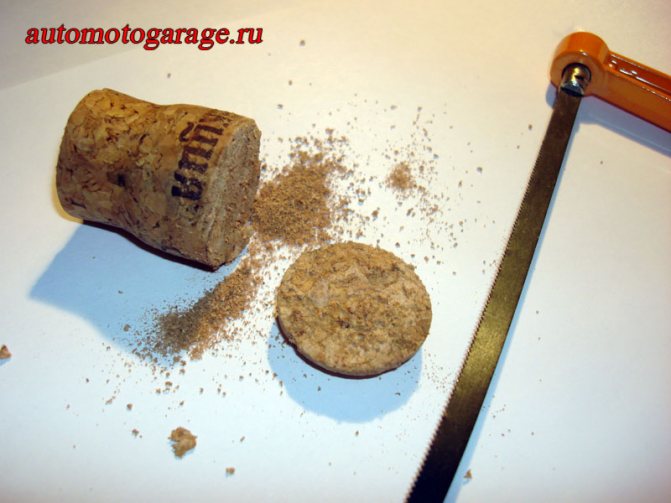
Then take a sanding block and sand the cut area.
Next, install a new gasket in the lid of the flask.
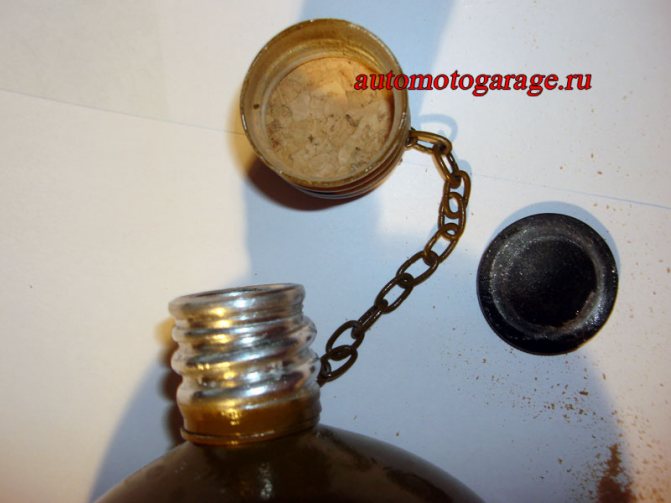
Screw the cap until the gasket is completely seated in place.
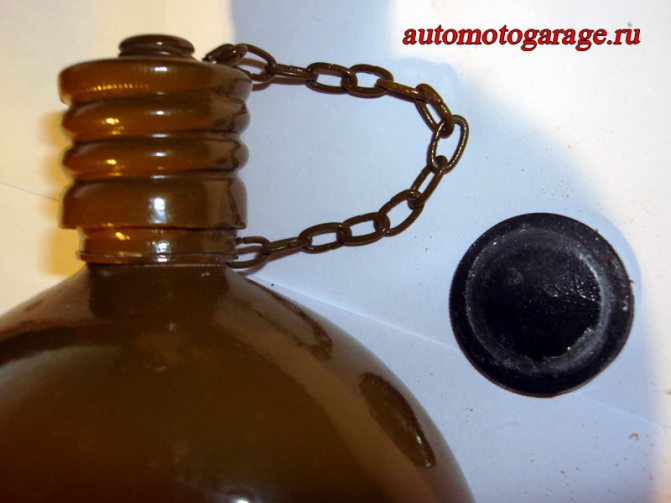
The next step is to check the flask for liquid leaks.
Option two.
Instead of a rubber gasket, you can use a polyethylene seal from a vodka bottle. In this case, there is no need to sharpen or saw anything. Simply remove the seal from one plug and insert it into the other (from the flask). But there is a possibility of leakage if you choose the wrong seal. In my case it doesn’t leak, but to be on the safe side I still use a balsa wood plug.
Finally, the flask must be rinsed to remove any grease that may have come from the press during manufacturing. Additionally, like an army bowler, the flask is not preserved at the factory.
Rinsing: pour five to seven tablespoons of baking soda, pour boiling water, close the lid, shake and leave for a day. Be careful it's very hot! Within a week I almost completely got rid of the smell in the flask. To finally get rid of the smell, I performed the same operation, only I left the flag flooded for a week. There is no smell! At least five flasks were deodorized using this method. The method works.
Storage: you need to store the flask in an open state, or if this is not possible, then with a slightly screwed on stopper.
Characteristics of combined army bowlers
The Army Combination Bowler aims to make it easier for military personnel to equip. The main element with a flask inside can be conveniently worn on a belt or in a backpack. The multifunctional kit allows you to prepare a complete lunch or dinner.
Equipment
The set from a warehouse or store comes standard with:
- Pot with rotating handle;
- A flask with a tightly screwed cap;
- Podkotelnik.

The factory set consists of a main element with a flask inside, which is inserted into the boiler compartment. The set can be placed in a case; it is purchased separately.
The aluminum army bowler is manufactured according to strict military standards. When assembled, it has dimensions of 180x160x90 mm.
Performance characteristics
All items in the set can be used to prepare a full meal, or individually.
Purpose of the main boiler:
- Container for cooking food in a standing or suspended state;
- Transferring liquid over long distances and transporting water to the cooking site;
- Product storage;
- Water collector;
- Technical needs.

Purpose of the flask:
- Liquid container;
- Metal option for making tea and other hot drinks;
- Like a sinker on hiking trips;
- Cleaning dirty water.
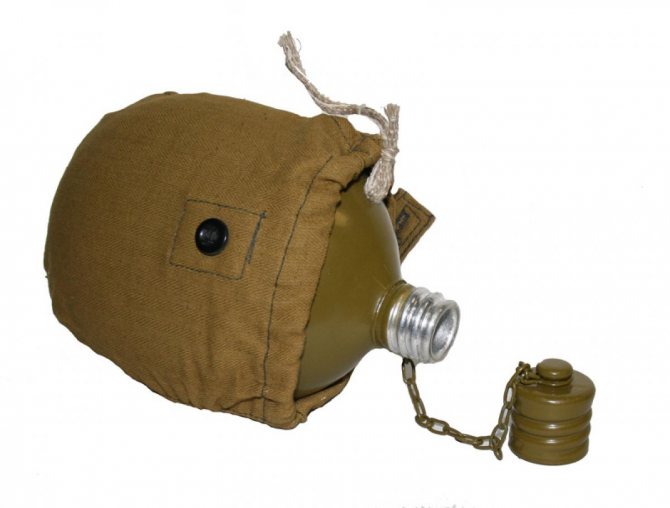
Purpose of the sub-boiler:
- Cover for the main pot;
- Scoop for water, sand;
- Mug;
- Frying pan;
- Like a plate for prepared food.
The kit case also has an important purpose. In addition to the main protective function against contamination of the elements, it serves as an additional item for collecting berries and mushrooms. In difficult times of war or during a long hiking trip, the structure serves to desalinate liquids, collect rainwater, and melt snow.
What did the soldier's bowler hat tell?
- October 14, 2020, 11:00
- Alfia GUBAIDULLINA
- Local history
In the museum of the village of Embayevo there is a soldier's aluminum pot.
It was presented to the museum of the village of Embayevo by front-line soldier Shagidulla Tukhvatullovich Tashkalov - a man of amazing destiny, a brave warrior and a wise teacher. The prototype of the Russian army bowler was the military field utensils of the Kaiser's Germany back in the First World War. Even then, the Germans established mass production of stamped bowlers; every soldier and officer received one. For this purpose, aluminum was used as an inexpensive, light and durable metal that appeared in industry at the beginning of the 19th century. Previously, metal utensils were made of copper, brass, bronze, iron and even silver. For a long time in Russia, bowler hats were produced according to the old model according to Order No. 76 of the Military Department of 1899. The modern type was developed in 1936 and had the features of a European cauldron - oval aluminum with a separate lid, with a clasp handle. After the war, the bowler hat was slightly modified, and this model is still in use today. Since 1940, bowlers began to be painted in green and yellow protective colors.

Bowler hat on a Red Army backpack, model 1936
When distributing food in the field, prepared in a field kitchen, the cook pours the first dish into the pot, and puts the second dish and a ration of bread into the lid. When preparing food, servicemen teamed up in twos: in one pot they cooked the first course, in the other - the second. The second pot is also used for making tea.
Need I say how dear an army bowler hat is to its owner? After all, if you have a pot and a spoon in your belt, you have confidence in the future, and your initials scratched on the pot will tell about you many years later. And if you survive and the war ends, then the bowler hat will be your friend for the rest of your life, a silent witness to a difficult time.
Shagidulla Tukhvatullovich Tashkalov was born on March 18, 1919 in the Yembaevsky yurts into a peasant family. He graduated from five classes of the Yembaevskaya basic school of the first stage of education, continued his studies at the Tatar-Bashkir department of the Tyumen Pedagogical College. Initially I studied the Tatar language at school, then Russian, and later German. A talented and diligent first-year student mastered the pronunciation and spelling of more than a thousand words from previously unknown languages in a week. After graduation, he was appointed to the Yantykovsky first-level school as a teacher and head. Then, as a young specialist in 1938, he was sent to open the Kyshtyrlin seven-year school in the Tyumen region. In 1939 he was called up for military service, and in 1941 he immediately stepped from peaceful military service into the heat of war. But after military service, the soldier dreamed of returning to his native village, to his favorite job at school, to his students.
War. Wherever the life of a front-line soldier took him! He was in reconnaissance, in open battle, and as a translator for captured Germans. I went on reconnaissance missions to get the language. Shagidulla fought his first battle on July 12, 1941, and on July 14 he was seriously shell-shocked and wounded in the left leg and right arm. In this state he was captured by the Nazis.
Already at the beginning of the war, it became clear that Stalin and the army leadership wanted to prevent the Red Army soldiers from being captured at any cost. The regulations of the internal service of the Red Army stipulated that a Soviet soldier could not be taken prisoner, but if he surrendered, then this would be treason. The first major battles in the pockets of Minsk and Smolensk, during which more than 600 thousand Soviet soldiers fell into the hands of the Wehrmacht, strengthened the pathologically mistrustful Stalin's suspicion that betrayal was involved. On August 16, 1941, Order No. 270 was issued. It stated that officers and political workers who surrender should be considered deserters, and their families should be repressed.
Complete clarity regarding the position of the Soviet government arose no later than August 1943. To make it clear to Soviet prisoners of war that they could not count on any help, the Wehrmacht high command ordered that a statement made by the Kremlin to the International Committee of the Red Cross be read out in all camps.
Soviet prisoners, who usually surrendered only after desperate resistance, must have felt betrayed by their own government, which did nothing to alleviate their fate.
Young guys, men were captured shell-shocked, wounded, tried to escape from captivity, hoped to get back into action to fight the hated enemy, to defend their beloved homeland. And the government of their homeland called them traitors.
After the surrender of Germany, Stalin ordered the organization of 100 filtration camps in the front-line armies, in which ten thousand former prisoners each had to undergo verification by the Smersh counterintelligence agency. The prisoners had the impression that they would escape the punishment “Motherland is a covenant!” - that was the name of the newspaper published for prisoners awaiting their repatriation in Germany. “The Motherland has forgiven you!” - they could read there. Until October 1, 1945, 5.2 million soldier citizens were “filtered” - prisoners, forced labor workers, as well as residents of the occupied Soviet territories. It is still unknown what percentage of those who were sentenced to punishment.

dumoo.ru
Death sentences were imposed mainly on senior officers. Prisoners who were tested in the "filtration camps" were mostly sentenced to ten years of hard labor.
After the end of the Great Patriotic War, soldiers who managed to escape from captivity and continued their heroic path to victory were subject to infringement of civil rights in peacetime. In application forms when applying for a job or university, there was a clause “about being in captivity or in occupied territories”; it was difficult for a former Soviet prisoner of war to become a member of the CPSU.
Relations in society were also far from smooth. People who were captured faced a wary and even contemptuous attitude.
In their letters, many former Soviet prisoners of war cite statements that in one form or another they heard addressed to them: “I shed blood at the front for my Motherland, and you sat in German captivity, ate German bread and worked for the Nazis.”
Shagidulla Tukhvatullovich Tashkalov made three escapes from captivity. The last one is successful. What desperate courage was possessed by the young soldier who made his escape! Hungry, he ran through the forests, guided by the stars, and fled to the east, to his own.
The fighter did not tarnish his military honor; he escaped from captivity to fight the hated enemy until victory.
After the war, Dean’s grown-up granddaughter asked him if he wanted to stay in another country to live. Grandfather simply said that after the end of the war, he knew that upon returning to his homeland he would have difficulties, but most of all he wanted to snuggle close to his native land, to breathe the air of his beloved village. This is how a person sincerely, selflessly loves his homeland.
With the rank of sergeant, assistant platoon commander, Shagidulla Tukhvatullovich Tashkalov continued to serve in the rifle battalion. In 1945, as an assistant platoon commander of the 257th Warsaw Regiment, he liberated Germany and reached the Reichstag.
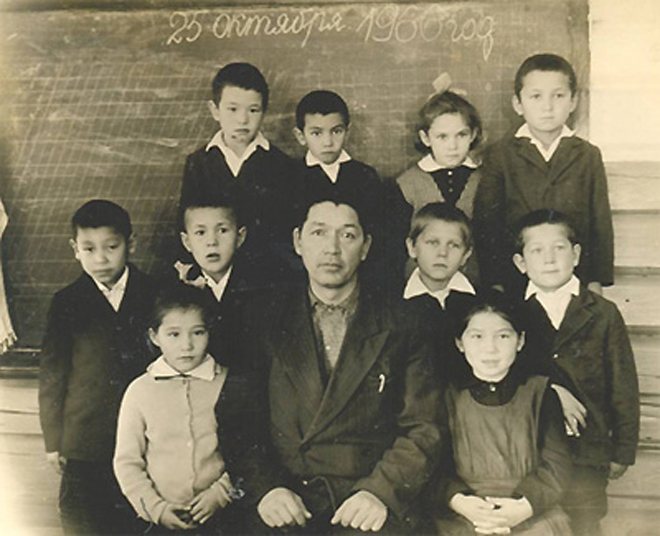
After demobilization in 1945, he worked as a teacher of history, chemistry, biology in his native village, then as a head teacher at the Yembaevskaya Tatar school. He created a strong, hard-working family. Shagidulla Tukhvatullovich did not really like to talk about the war, about what he had to endure during the hard years of fire, like many front-line soldiers. But the memory did not let go. Those days were too hot and scary. The front-line soldier wanted people to remember the great feat of the people who defeated fascism.
He brought his soldier's bowler hat as a gift to the village museum; he went into battle with it, rested with it at rest stops, and it happened that several soldiers ate from one bowler. An old, battered aluminum pot is a memory, a fragment of the heart.
Shagidulla Tukhvatullovich Tashkalov passed away on a cold December day in 2001. Everyone who knew him remembered him as a kind, sympathetic person. He was also a man with a great thirst for knowledge. In his mature years, having learned the Arabic alphabet, he fluently read the holy books of Muslims. He was appointed the religious center of Ufa by the mullah of the Embaevskaya mosque.
For services to the Fatherland, Shagidulla Tukhvatullovich Tashkalov was awarded the Order of the Patriotic War, first degree, medals “For Victory over Germany”, “For Military Merit”, medals in honor of the anniversaries of Victory in the Great Patriotic War, the medal “50 Years of the Armed Forces of the USSR” and other awards . For many years of teaching work, he was awarded a Certificate of Honor from the Ministry of Education of the RSFSR and other awards.
Shagidulla Tukhvatullovich Tashkalov loved his family, his work, his homeland. He lived a hard life, but he lived it beautifully and with dignity.
Our land is rich in heroic, brave, valiant, hardworking people. A simple soldier's bowler hat told us about one of them. There are many more exhibits in the village museum; we will also try to tell you about their owners.
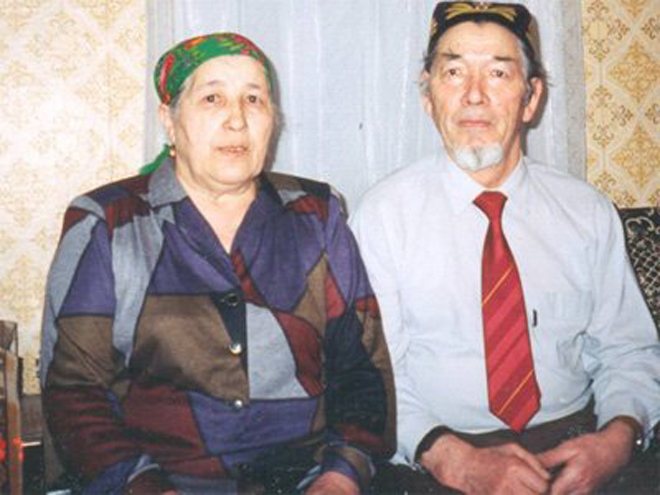
Swedish army bowler hat M39
SHAK is an abbreviated name for an army bowler hat originally from Sweden. This set has gained popularity among the civilian population due to its versatility and compactness. The set includes: main pot, mug with lid, casing, alcohol burner and alcohol burner. The functional element is equipped with a handle with a hook for the fire, and there are also convenient holders on the sides.
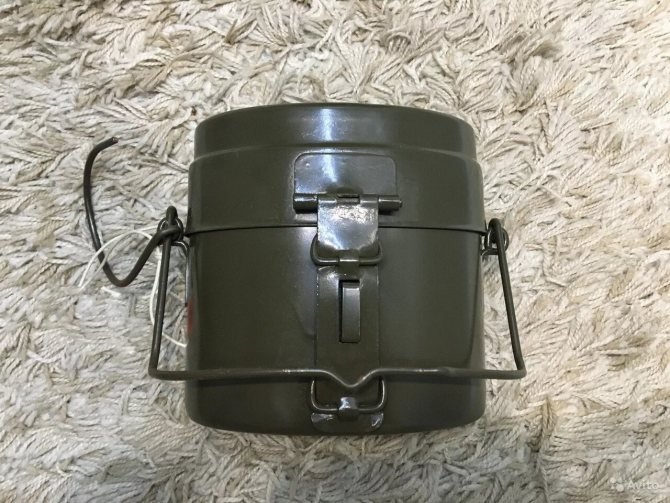
The functional element is equipped with a handle with a hook for the fire, and there are also convenient holders on the sides.
Only alcohol can be used in the burner, as rubber parts will melt when they come into contact with gasoline. The casing reduces fuel consumption and is usually made of steel or aluminum. A plastic flask and burner will fit freely into the main pot. Spoon and mug are purchased separately.
Children's construction set - fan with thermoelectric generator
Hello everyone. I present to you another set for assembling a visual aid for physics lessons, the electricity section, or just a model of a fan with a thermoelectric generator. Contains an electric motor and a power source in the form of a Peltier element. This visual aid shows how you can use alternative energy sources, and simply broadens your horizons. You can call it a toy, but with a reservation, because hot water is used. So, for those who are interested, please refer to the cat. According to Wikipedia, a Peltier element is a thermoelectric converter, the operating principle of which is based on the Peltier effect - the occurrence of a temperature difference when an electric current flows. In English-language literature, Peltier elements are designated TEC (from the English Thermoelectric Cooler - thermoelectric cooler). Many have already heard about such elements, and some have already used them for their own purposes. A clear example of the use of a Peltier element is a water cooler in an office. Cooled water is obtained using a Peltier element. But in our case it should be the other way around. We must get electricity from this element. In this case, the opposite effect of the Peltier effect, called the Seebeck effect, will help us. The Seebeck effect is the phenomenon of the occurrence of EMF in a closed electrical circuit consisting of series-connected dissimilar conductors, the contacts between which are at different temperatures. The Seebeck effect is also sometimes simply called the thermoelectric effect. Simply, when one side of the element is heated or cooled, electricity is generated. This particular constructor is designed to use the Seebeck effect and by assembling it we will obtain a thermoelectric generator. A striking example of a thermoelectric generator that became widespread in the post-war years is the TGK-3 thermogenerator:
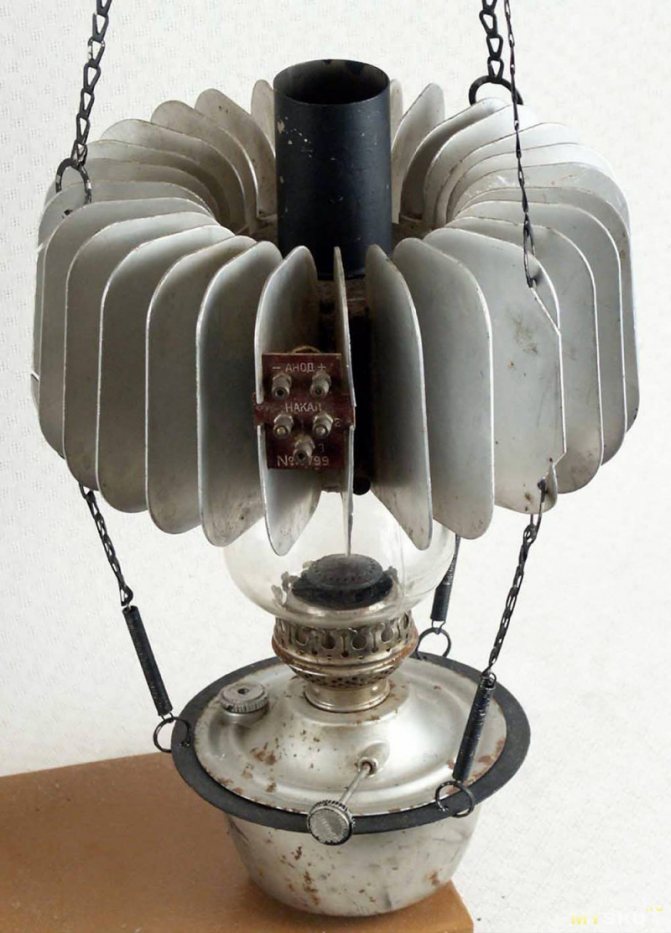
The source of heat and, incidentally, light was an ordinary kerosene lamp. The developed fins provided the maximum possible temperature difference for generating electricity. An earlier version of the TG-1 thermogenerator was used during the Great Patriotic War from 1943 in partisan formations and was a good help for batteries and car-based generators.
Partisan bowler hat
When the Great Patriotic War began, physicists at the Leningrad Institute of Physics and Technology developed the TG-1 thermoelectric generator, known as the “partisan pot,” specifically for partisans and sabotage groups thrown behind enemy lines. The work on its creation was led by one of Ioffe’s colleagues, Yuri Maslakovets, who became interested in thermoelectric phenomena in semiconductors even before the war. TG-1 really looked like a cauldron, was filled with water and placed on a fire. The semiconductor materials used were a compound of antimony with zinc and constantan, a copper-based alloy with the addition of nickel and manganese. The temperature difference between the fire flame and the water reached 300° and was sufficient to generate current in the thermoelectric generator. As a result, the partisans charged the batteries of their radio station. The power of TG-1 reached 10 watts. The generator was launched in March 1943 at Research Institute 627 with Pilot Plant No. 1.
We have become familiar with the purpose and principle of operation, now let’s move on to our designer.
Delivery and packaging:
Delivery by transport company in 19 days.

I hoped that with such packaging nothing would happen to me.
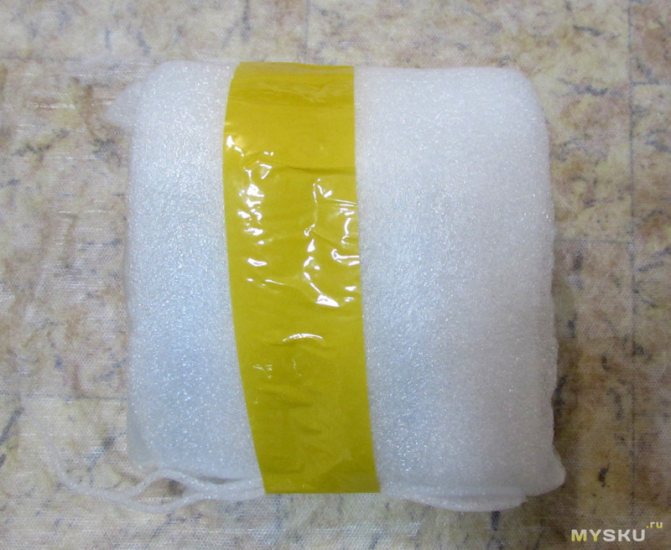
Standard packaging from a double bag with parts poured inside.
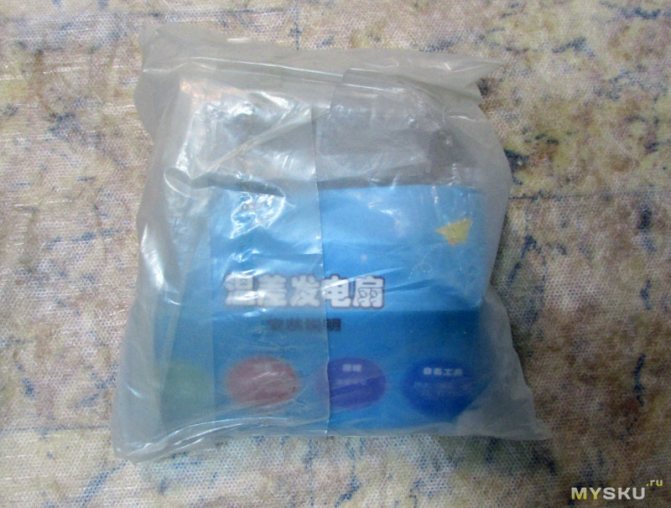
We open the package:
Plywood base, several identical bars. Some of them are used as legs. Bar for the stand. Polypropylene latch for fastening the electric motor. The electric motor itself and a tube of glue. This photo does not include a container with a lid for cold water. More on this later.
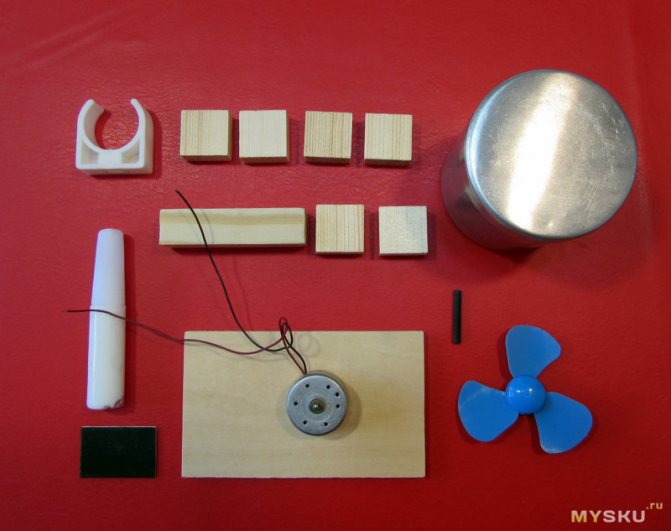
A glass with a lid for hot water. Made of aluminum, transfers heat well. Dimensions 60x60 mm. The power plant of the set was hidden inside the glass - a Peltier element with an installed radiator. The capacity of the glass is at least 100 milliliters.
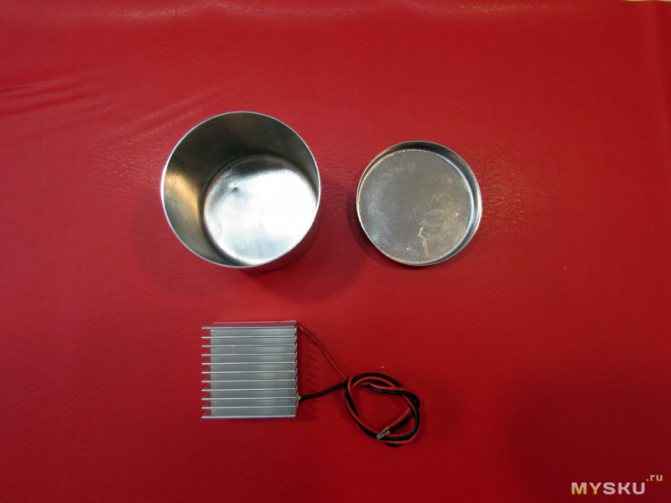
Instructions:
You don’t have to follow these instructions when assembling, because the cat has lost all the parts.
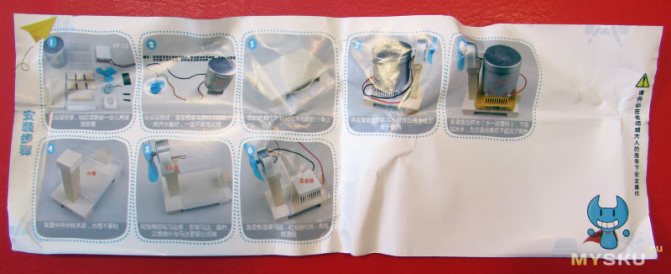
A little bit of tar:
Even though the plastic box was in a separate bag, it was still damaged. I took out the fragments and glued them in place using dichloroethane. There were traces left, I smoothed them out a little with sandpaper.

The source of electricity is a Peltier element: Unfortunately, there is either no marking, or there was one, but on the other side.
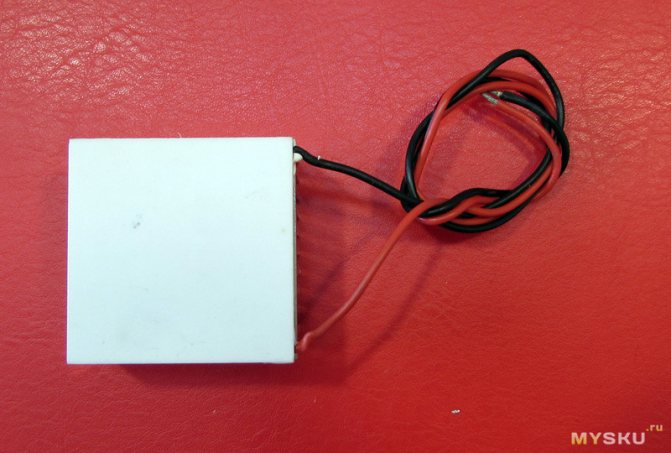
The element is glued to a radiator measuring 40x40x20 mm and has 11 fins. By the way, a similar radiator can be obtained from the bridge (north or south) of an old motherboard.
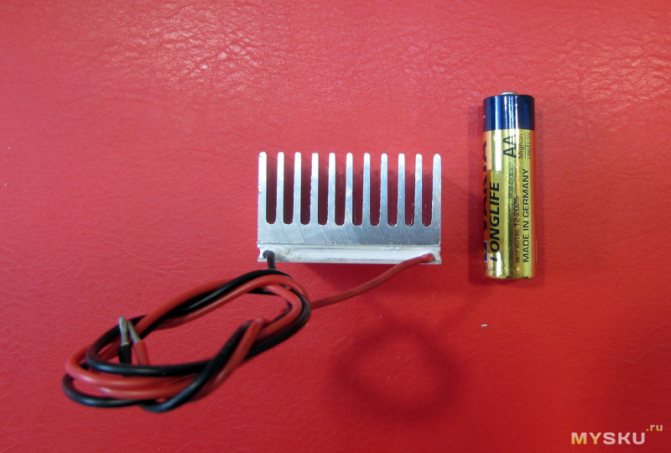
Interesting detail, doesn't remind you of anything?
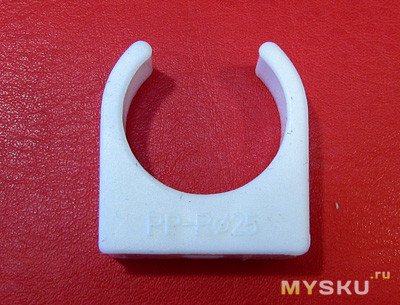
Yes, this is a 1 inch polypropylene pipe holder. However, it copes with fixing the electric motor with a bang.
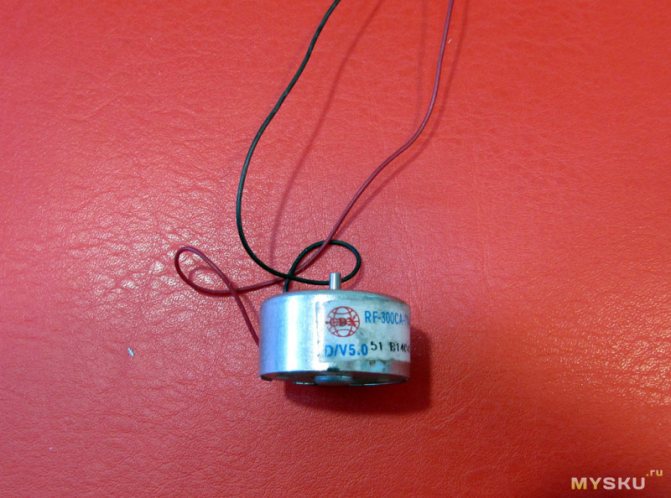
The electric motor is very weak. Operating voltage 5 Volts. 100% of the same can be obtained by disassembling an old CD-Rom in which the motor is responsible for moving the tray.
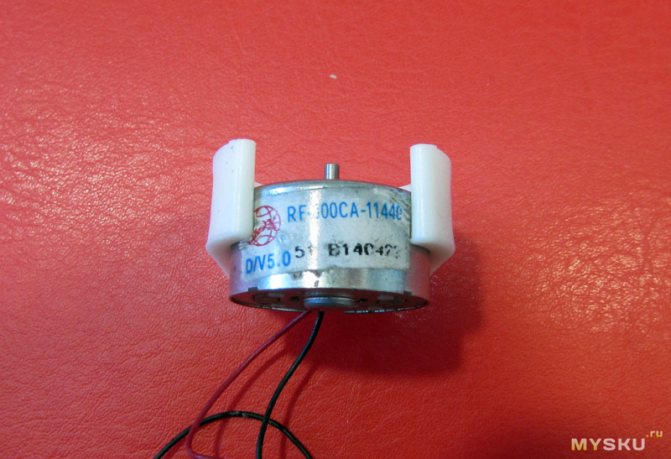
The fan is 3-bladed, diameter approximately 55 mm. Slides directly onto the motor shaft. For some reason it reminded me of Carlson, who lives on the roof.
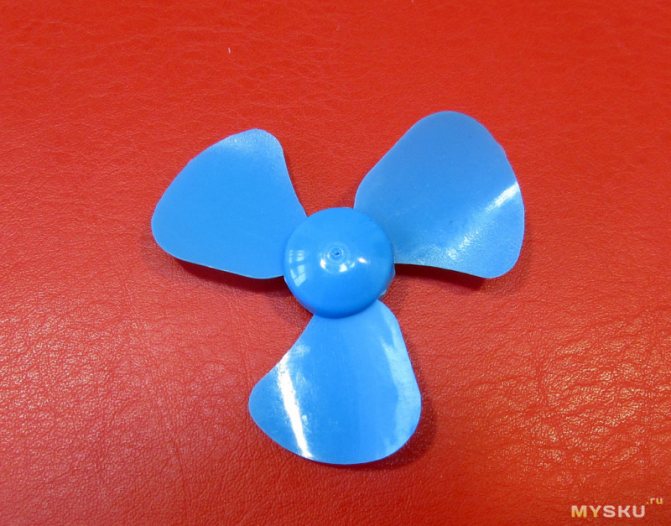
The glue this time is actually identified as PVA. Not frozen. Glues well and quickly.
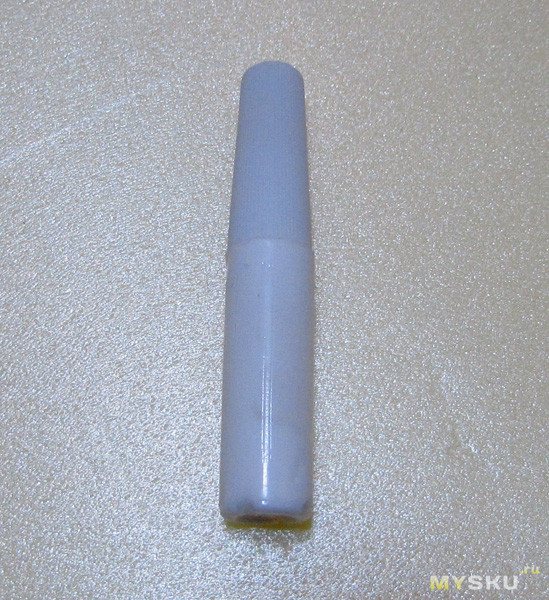
Build process:
We fix the legs on the base. We install a block that limits the movement of the bath. We fix the bath with double-sided tape and then fix the long block perpendicular to the base. Next, using PVA glue, we fix the polypropylene clamp with a motor with a fan pre-installed in it. For reliability, you can fix it with a small screw. Electrical part - we connect the wires of the electric motor by color with the wires of the Peltier element and insulate them with heat-shrinkable tubing. At this point the assembly can be considered complete.
To start the designer, you need to pour cold water into a transparent container about 2/3 full, lower the radiator with its ribs down and place an aluminum cup on top into which we already pour hot water. For a better visual effect, it is better to pour boiling water. In any case, the greater the temperature difference, the more power the generator will give to the motor and the higher the fan speed will be.
The bath is fixed to the base using PVA glue. According to the instructions, it was necessary to use double-sided tape. But since I treated the surface with sandpaper, it stuck just fine. There is no need for a pressure bar.
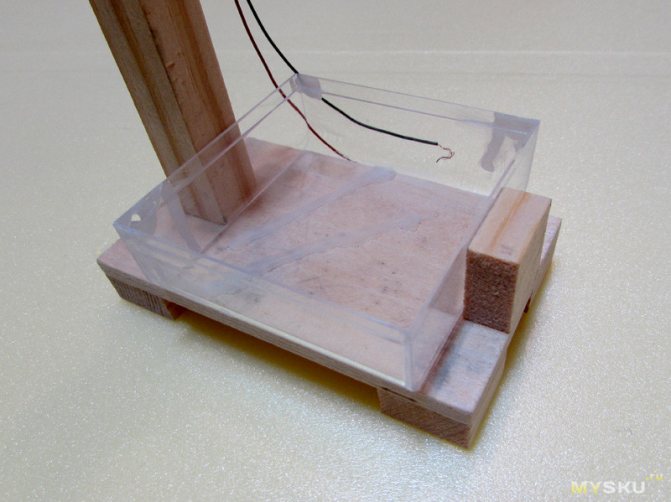
I made a small mistake during assembly. The screw touched a rectangular block. I had to move the motor forward a little. Also, the block could not be installed.
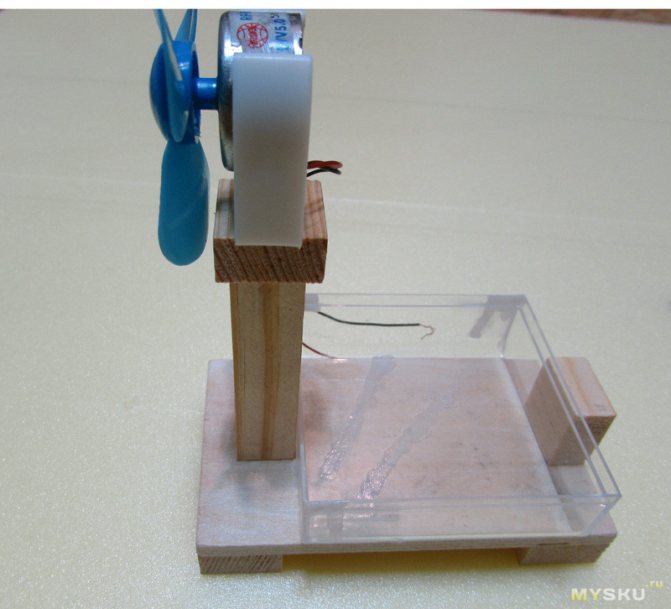
Let's try. Does not work! A slight push on the blade and the fan quickly picks up speed.
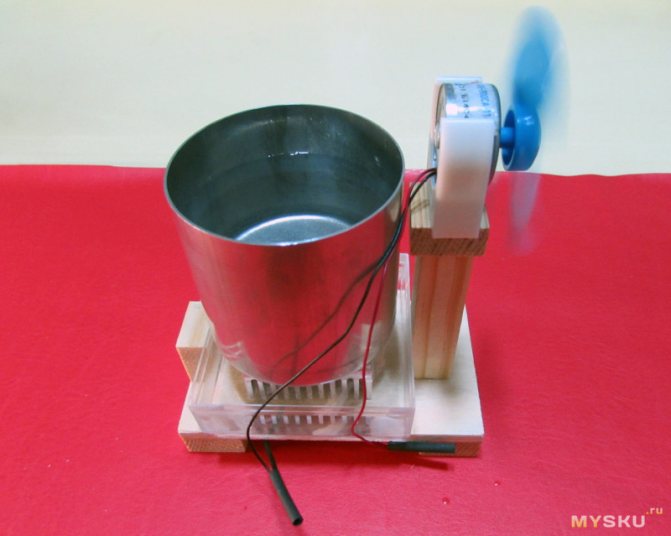
Our temperature is: 5 and 72 degrees Celsius, respectively. In this case, the voltmeter shows 0.8 Volts. This is the value under load in the form of an electric motor.
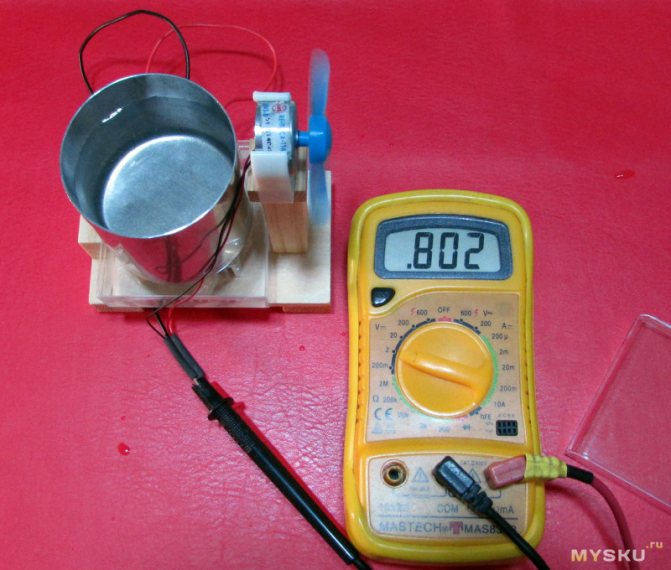
The tachometer recorded a maximum speed of about 1400 per minute.
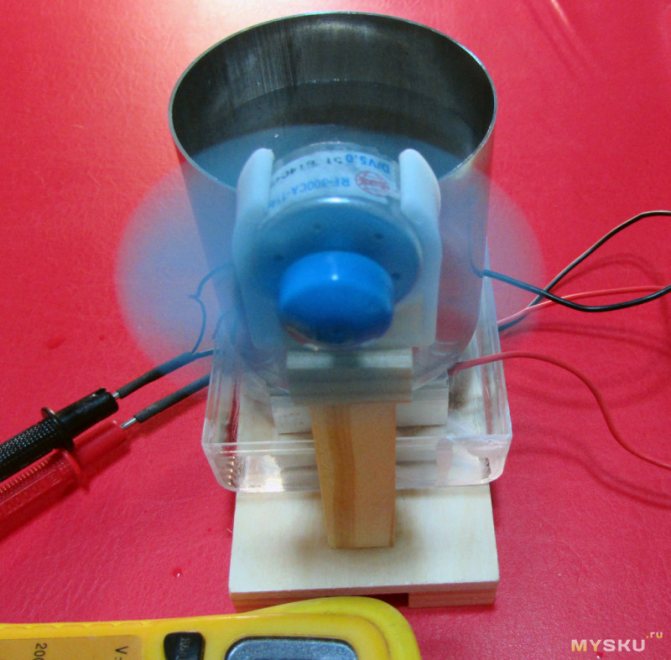
For better contact of the cup with the Peltier element, I used heat-conducting paste, which I bought once on Aliexpress.
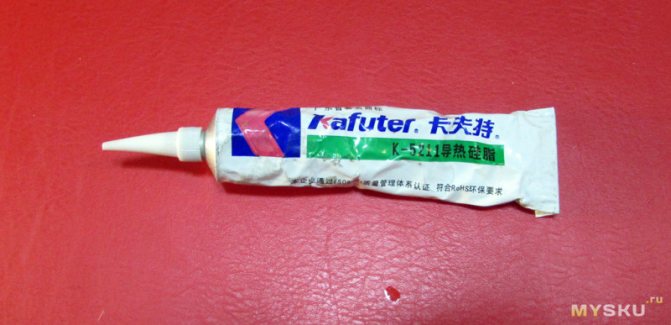
With its use, it is not necessary to push the fan impeller. The motor spins up on its own. You can increase the efficiency a little and level the bottom of the cup. Although it is stamped and does not look wrinkled, its surface can be improved with fine sandpaper and a flat surface. Hurray, now it works independently and with less temperature difference! Want more?! Run the engine, the speed will increase a little. You can also increase the temperature difference.
The video demonstrates the assembled layout from all sides, as well as in working condition. The rest of the video, starting at 1:28, is about assembly.
Warning:
Due to the use of hot water, it is highly advisable to carry out test runs under adult supervision. A glass made of aluminum can be as hot as the water inside. Either cover it with self-adhesive insulating material, or handle it with gloves or pliers. The motor power is weak, so if the impeller hits your fingers, it’s okay. It won't hurt.
Conclusions:
Interesting, simple set. You can keep your child busy for the evening and broaden his horizons. Not everyone can play toys on the phone. Wooden parts are sawn with high quality. There are also no burrs. Wood - linden or aspen. The designer is designed for children from primary school and above. The accuracy and precision of assembly does not affect the final result. I recommend using a soldering iron to solder wires. An alternative is to twist the wires. Difficulties were caused by fixing the column to the base; either you had to wait longer for the glue to set, or use a screw.
The platform is quite universal. Instead of a Peltier element, you can use, for example, photocells or make a reversible option - An electric motor generates electricity and powers, for example, an LED. Or you can make a boat using a foam body. You'll get an airboat. As a table fan, the idea is hardly feasible. As you noticed, many parts can be obtained locally. All that remains is to buy a Peltier element and do everything yourself. That's all. Thank you for your time.
The product was provided for writing a review by the store. The review was published in accordance with clause 18 of the Site Rules.
In the Russian Armed Forces
An army cauldron in the Russian Federation has standard dimensions: 150 × 100 × 170 mm, lid volume 0.5 liters. The pot is made of aluminum in accordance with GOST and painted green. This design was used during the 2nd World War. During military training, lunch is laid out in the main element, where the pot itself serves as a container for the first course, and the lid serves as a plate for the second course.
The volume of the USSR army pot was 1.3 liters, this size remains the same today.

During military training, lunch is laid out in the main element, where the pot itself serves as a container for the first course, and the lid serves as a plate for the second course.
The Russian Airborne Forces use another option, where the kit includes a bowler hat with a flask inserted inside. In the 90s, a boiler frame was added to the set, and the dimensions changed accordingly: 182 × 160 × 90 mm. The volume of the army pot is 1 liter.
Combination boiler VDV
As everyone knows, the airborne combi flask was accepted for supply to the USSR Airborne Forces by Order No. 78 of 09.17.59. “On the acceptance of an aluminum combined pot with a flask for supply to the Airborne Forces” in 1959. She looked like this: In 1971, the combined pot-flask was modernized. The edges of the flask are removed and another component is added to the kit - a ladle. Also, the combined pot-flask is complemented by a cover made of khaki-colored fabric. In the early 80s, another modernization took place - plastic flasks appeared. To be honest, this is the worst flask; in it, the water goes out faster than in aluminum, and thank God you won’t find it anywhere. 1. A flask with a capacity of 1 liter, externally repeating the internal dimensions of the pot. Material – aluminum. Weight – 220 gr. In later modifications of the kit, the flask began to be made of plastic. 2. The pot has a capacity of 1 liter and has a rectangular handle for carrying and hanging over the fire. Material – aluminum. Weight – 200 gr. 3. Bowl with a capacity of 0.5 liters with a folding handle-lock. Material – aluminum. Weight – 140 gr. 4. For storage and transportation, it is supplied with a canvas cover. Weight – 80 gr. Weight of the set without case:
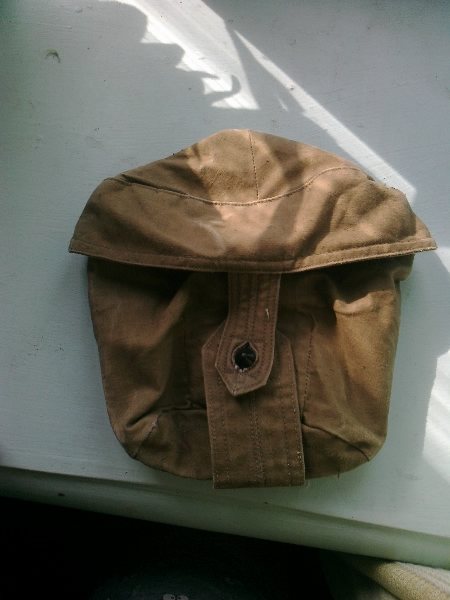
empty - 560 gr. filled with water - 1.560 g. total weight in the case without water – 640 g. Now about the advantages of this set: 1. With a minimum presence of containers, it allows you to heat or cook hot food for one person in the field. 2. The design allows you to cook food equally conveniently over a fire, on alcohol and gas burners, as well as on various taganka stoves. 3. Compact when carried (kettle, pot and flask can be carried in one item) 4. Relatively cheap and affordable product. 5. During production, a thicker sheet of aluminum was used than in the manufacture of a conventional military cauldron, hence the increased strength and durability of the product. Thicker material also ensures even heat distribution and reduces the risk of food burning. 6. The main capacity of the pot has a more suitable and rational volume of 1 liter for use by one person compared to a general-arms pot, the volume of which is about 1.5 liters. 7. The bowl-lid is more convenient than the lid-bowl from a general-arms cauldron due to the increase in depth while maintaining the same volume. 8. Increased volume of the flask compared to the combined arms version, although there is a modification of 1 liter (0.8 liters). 9. Thanks to the metal (aluminum) body of the flask and its flat bottom, after unscrewing the cap, you can boil water in it, like in a kettle, distillation is also possible: https://vizhivai.com/encziklopediya/voda/item/471-distillyatsiya- kombinirovannyiy-kotelok-s-flyagoy-nedokumentirovannyie-vozmozhnosti. Now we have come to the disadvantages of this kit (although you can fix them yourself): 1. The roughly made neck of the flask with large screw threads, combined with an often uneven edge, often does not ensure the quality of fit and tightness of the screwed cap, as a result of which water may leak. It can be treated by replacing and adjusting the internal seal 2. The stopper uses black sealing rubber, which after prolonged use gives an unpleasant odor to the water carried in the flask. It can be treated by periodically replacing the seal, or you can replace the rubber with a Selekon seal. 3. The small diameter of the neck is inconvenient to use. The inside of the flask is difficult to clean. It is difficult to collect water from open sources. 4. Insuring the stopper against accidental loss is made in the form of a steel chain, which tends to knock on the flask while moving and especially when running, when the flask is located on the belt, which can also be considered a kind of disadvantage. 5. Some inconvenience is caused by the need to put the bowl-under-pot on the pot from below. After cooking over a fire, if it is not possible to properly wash the pot, you will have to put the bowl-under-pot on the dirty, sooty pot with the inside. To solve this problem, I sewed a cover for the pot from unnecessary fabric, or simply put any fabric under the pot and then the under-pot will be clean. 6. There is no place for a spoon. As a way out, you can sew an additional pocket on the cover. In general, the pot combined with a flask is convenient to use. Some solutions to problems were indicated, but I did not encounter other problems. Good luck to all.
In the American army
The American Army completely abandoned the use of field kits in the early 19th century. Since the 20th century, the United States has moved towards centralized food preparation, so employees were given a meal kit instead of a pot. The set included: a shallow plate, spoon and fork.
Today, American soldiers are given rations that include disposable plastic utensils.
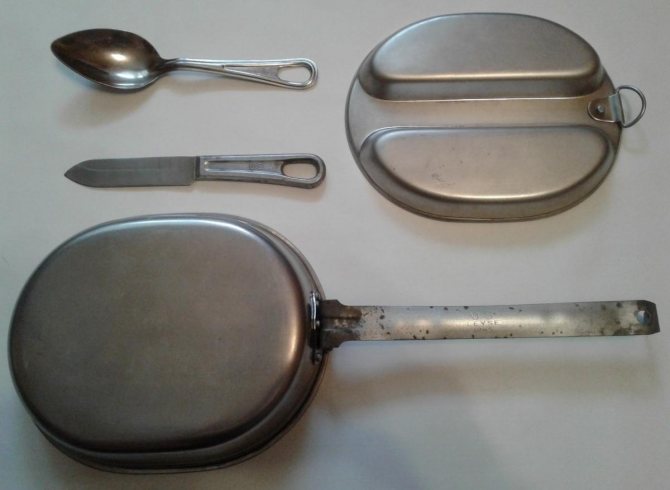
Since the 20th century, the United States has moved towards centralized food preparation, so employees were given a meal kit instead of a pot.
DIY partisan pot

high thermoEMF and low thermal conductivity.
At the beginning of the war, a “partisan boiler” was created in Ioffe’s laboratory - a thermoelectric generator to power portable radio stations. It was a pot with thermocouples located on the outside of the bottom. Their flammable joints were in the fire of the fire, and the cold ones, attached to the bottom of the pot, were cooled by water poured into it.
Careful selection of materials and the use of regeneration have now made it possible to increase the efficiency of the thermoelement to 15%. At the beginning of the century, conventional power plants had this efficiency, but now it has more than tripled. There is currently no place for a thermoelement in the large-scale energy sector. But there is also small energy. Several tens of watts are required to power a radio relay station on a mountain top or a marine signal buoy. There are also remote places where people live who require electricity and heat. In such cases, thermoelements heated by gas or liquid fuel are used. It is especially valuable that these devices can be placed in a small underground bunker and left completely unattended, only once a year or less often to replenish the fuel supply. Due to the low power, its consumption at any efficiency turns out to be acceptable, and in addition. no choice.
Doctors have found an interesting application for thermoelectric generators. For more than two decades, thousands of people have worn an implanted cardiac pacemaker placed under the skin. The energy source for it is a tiny (thimble size) battery of hundreds of thermocouples connected in series, heated by the decay of a harmless isotope. A simple operation to replace it is performed every 5 years.
Electron is produced in Japan
A watch that is powered by a thermoelement from the heat of the hand.
Recently, an Italian company announced the start of work on an electric car with a thermoelectric generator. This current source is much lighter than batteries, so the mileage of a thermoelectric car will be no less than that of a conventional one. (Recall that electric cars are capable of traveling ISO km with one charge.) It is believed that through various tricks, fuel consumption can be made acceptable. The main advantages of the new type of crew are absolutely harmless exhaust, silent movement, the use of the cheapest liquid (and possibly solid) fuel, and very high reliability.
In the 1930s, the work on thermoelements carried out in our country was widely known. This is probably why the writer G. Adamov described in his novel “The Secret of Two Oceans” the Pioneer submarine, which received energy from battery cables. This is what he called thermoelectric generators made in the form of long cables. With the help of a buoy, their hot junctions rose to the upper layers of the ocean, where the temperature reaches 20-25°C, and the cold junctions were cooled by deep-sea water with a temperature of 1-2°C. This is how the fantastic “Pioneer”, a boat capable of giving a hundred points ahead of the current nuclear ones, charged its batteries.
Is this real? There are no reports of direct experiments of this kind in the press. However, something interesting happened. A 1000 kW thermoelectric generator has been created, generating energy from the heat of hot underground springs. The temperature difference between the hot and cold junctions is 23°C, as in the ocean, the specific gravity is 6 kg per 1 kW - much lower than that of the power plants of conventional submarines. Are we on the verge of a new energy revolution, a new age of electricity?
high thermoEMF and low thermal conductivity.
At the beginning of the war, a “partisan boiler” was created in Ioffe’s laboratory - a thermoelectric generator to power portable radio stations. It was a pot with thermocouples located on the outside of the bottom. Their flammable joints were in the fire of the fire, and the cold ones, attached to the bottom of the pot, were cooled by water poured into it.
Advantages and disadvantages of an army bowler hat
Like any product, a soldier's bowler hat has a number of pros and cons.
Positive sides:
- The army camp bowler is a universal set that is convenient during transportation and use;
- A minimum set of elements allows you to prepare a complete lunch;
- The soldier's bowler can be used on a gas and alcohol burner, on an open fire;
- Affordable price;
- The lid of the flask can be replaced with a plug.
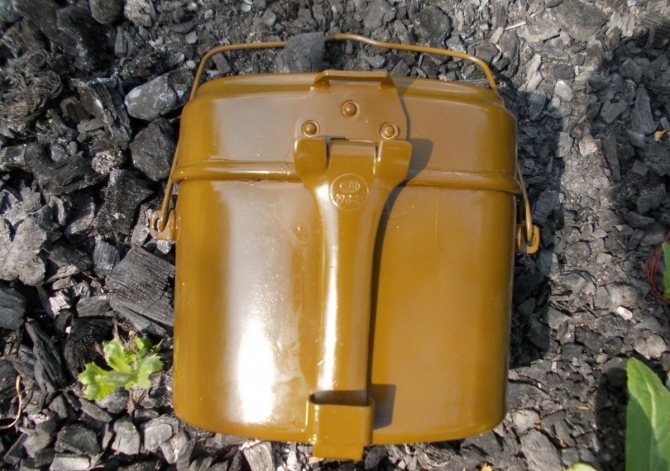
Negative sides:
- The flask is equipped with a rubber seal; during the process, the material absorbs and retains unpleasant odors. The way out of the situation is to replace the element with a cork version;
- The safety plug is attached to the container with an iron chain, which creates a certain sound when walking. The solution is to replace this element with a rope or elastic band;
- With constant use on an open fire, soot is formed, which is difficult to remove from the surface;
- Sand and earth get between the flask and the pot, making it difficult to separate them;
- The main element of the set is unstable, so it is recommended to carefully monitor the pot during the cooking process;
- The metal handles get very hot, so grab the handles with a rag.
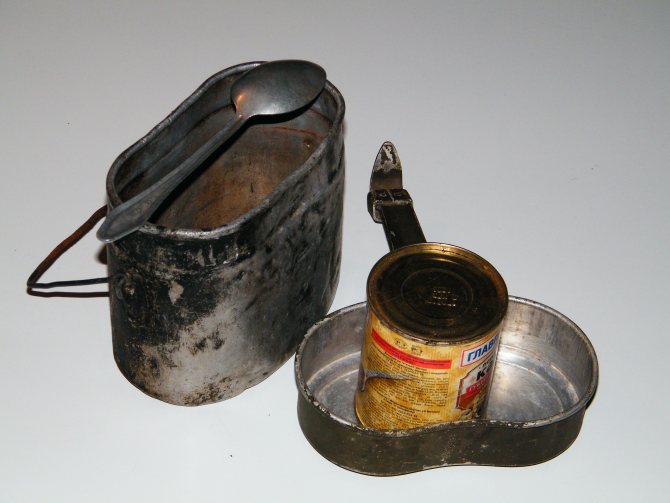
The weight of the set is minimal, so it does not create discomfort while wearing. You can also reduce the load by removing the firebox or cover, and replacing the flask with aluminum or plastic containers.
Advantages and disadvantages of the kit
Its advantages:
Is it possible to make a fire in the forest?
- Versatility.
- Convenience and compactness.
- Allows you to cook or reheat many types of food and drinks.
- Allows you to cook food on different heat sources: fires, burners, stoves.
- Made from very dense aluminum sheet. This is the key to its strength and durability. Also, during cooking, the heat is distributed evenly and the food does not burn.
- Economical volume for use by one person.
- The neck has a weak diameter. This is how water is consumed in doses.
- The flask is suitable for boiling water.
- Reasonable price.
Weak sides:
- The plug has a rubber seal. After long use, it gives the water in the flask a nasty smell. Instead of rubber, you can use a cork seal.
- When moving, the safety chain knocks on the flask if it is on the belt. Solution: use belay in the form of a rope.
- When the flask is not completely filled, it clicks loudly. Solution: use a tourniquet, cellophane or newspaper.
- It is difficult to remove soot from the boiler. Solution: clean it thoroughly with sand or earth.
- The structure is difficult to disassemble when sand or dirt penetrates into the joint areas of the containers. Solution: use cellophane bags or a plastic flask.
- Some models have a bad folding pot handle, its length is longer than necessary. Solution: you need to set the opposite vector for attaching the handle to the pot.
- The pot is not stable. Solution: you need to consider installing it on coals so that they burn out. You can hang the pot over the flame.
- The handle of the boiler heats up strongly and very quickly. You should tie a rag or stick to it.
Preparation for use
The army kit arrives from a warehouse or store treated with grease. Therefore, before use, it is necessary to boil all elements in a soda solution. After complete drying at room temperature, the pot and other items are wiped with a soft towel. Wash the flask and the main container inside with alcohol or boiling water. After all procedures, the kit is ready for use.
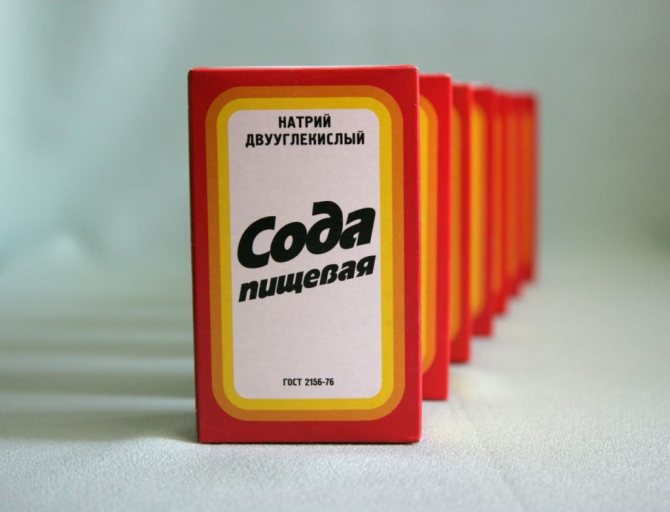
Before use, all elements must be boiled in a soda solution.
If a soldier's bowler hat is painted, it cannot be used on an open fire. Experienced tourists and fishermen remove paint before going on a trip.
How to wear an army bowler hat on a belt
A soldier's bowler hat must be worn on a belt in a casing. There are two reasons for this: firstly, it is convenient, metal objects will not come into contact with the body, which will prevent damage to clothing, and secondly, during the cooking process, the product becomes covered with soot, which can ruin things.
And one more important point - the concave side of the military bowler is specially designed to be worn on a waist belt; it follows the ergonomic structure of the human body.

A soldier's bowler hat must be worn on a belt in a casing.
A soldier's camping bowler hat is an irreplaceable thing for hiking and outdoor recreation. The compactness and versatility of the product allows you to reduce equipment and prepare a complete diet for the whole day.
Design
The most common option is a container with a convex-concave bottom profile, concave on one side. But it can also have a spherical shape. Equipped with a wire loop handle for hanging and carrying. When worn on a waist belt, the concave side should be towards the body. The lid of the pot can be used as a frying pan when heating or preparing a second dish. The handle of the lid is designed to hold it, securely locks the lid when carrying it, a tablespoon is inserted into special holes on the handle.
The non-axisymmetric, but well-known, shape of a soldier's bowler hat makes it a convenient subject for research on deep metal drawing[1].
